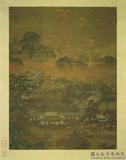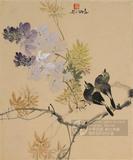明陳洪綬畫壽萱圖 軸
推薦分享
資源連結
連結到原始資料 (您即將開啟新視窗離開本站)後設資料
- 資料識別:
- 故畫001367N000000000
- 資料類型:
- 類型:繪畫
- 型式:靜態圖像
- 著作者:
- 陳洪綬
- 主題與關鍵字:
- 奇石 竹 萱花
- 出版者:
- 數位化執行單位:國立故宮博物院
- 格式:
- 本幅 107.5x42.5公分、全幅 59公分
- 關聯:
- 故宮書畫錄(卷五),第三冊,頁483 &*故宮書畫圖錄,第九冊,頁130-104&* 陳洪綬(西元一五九九至一六五二年),浙江諸暨人。字章侯,號老蓮,甲申清人入主中原後,自稱悔遲,又稱勿遲。人物花鳥草蟲無不精妙,皆能自出機杼,表現高古奇駭,意趣盎然之特色,為晚明變形主義畫風之大家。 陳洪綬所畫工筆雙鈎之花鳥畫,得益於五代徐熙、黃筌和宋徽宗,設色古雅。此幅畫萱花竹石,其中花竹多勻稱如篆書之筆觸;石則以多楞角之線條鈎劃輪廓,可見老蓮常用之技法。 &*Day-lilies, Bamboo and Rock Ch’en Hung-shou (1598-1652) Ming dynasty Ch’en Hung-shou was a native of Chu-chi, Chekiang. A “left-over” subject of the Ming, he styled himself Hui-chih (Late for Repentance) following the fall of the dynasty, only to take the sobriquet Wu-ch’ih (Not Late) as well. His figure insect, and bird-and-flower paintings are all excellent, each expressive of Ch’en’s unugual, lyrical view of the world. Ch’en Hung-shou’s fine brush, outline style of bird-and-flower painting was inspired by the traditions of the Five Dynasties painters Hsü Hsi and Huang ch’üan, and the Northern Sung emperor Hui-tsung. The coloring is antique and refined. This painting portrays day-lilies, bamboo and a rock. The brushwork of the bamboo suggests the ancient seal script of calligraphy, and the rock is described with angular outlines -- both characteristic of Ch’en’s style of painting. &*1.〈明陳洪綬畫壽萱圖〉,收入國立故宮博物院編,《晚明變形主義畫家作品展》(臺北:國立故宮博物院,1977年九月初版),頁454。
- 管理權:
- 國立故宮博物院
授權聯絡窗口
- 國立故宮博物院圖像授權、出版授權、影音資料授權-申請流程說明
http://www.npm.gov.tw/zh-TW/Article.aspx?sNo=03003061






